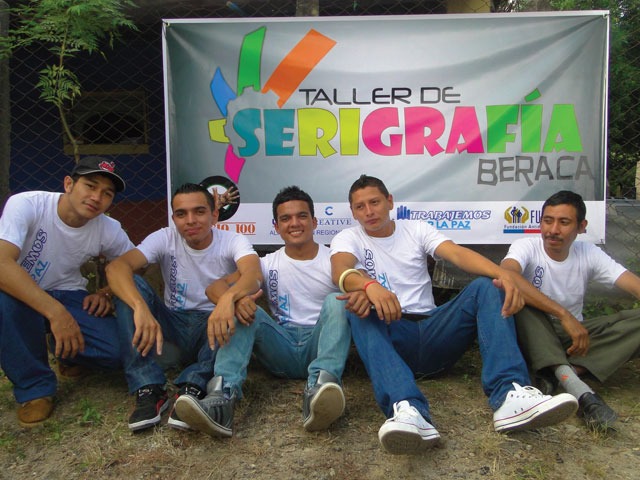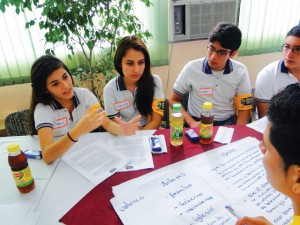CENTRAL AMERICA:
Creative Projects Spawn Anti-Violence Movements, Transcend BordersJuly 12, 2012

Central American youth during a silk screen printing workshop.
President Barack Obama’s words of encouragement to American students in 2009 also hold true for Central America’s up and coming Youth Movement. President Obama told America’s young people, “And even when you’re struggling, even when you’re discouraged, and you feel like other people have given up on you, don’t ever give up on yourself, because when you give up on yourself, you give up on your country.” In El Salvador, Guatemala and Honduras, three of the most violent countries on the planet, some youth are not giving up on themselves or their countries. Instead, they are reclaiming their communities by working to mitigate the violence that is robbing them of a better future.
The violence these young people face is frightening and it is pervasive. Honduras’s homicide rate is 82 per 100,000 according to the UN Office on Drugs and Crime. Young people represent six deaths out of every 10. Youth are both the perpetrators and victims of crime. With similar figures in El Salvador (66 per 100,000) and Guatemala (41 per 100,000) the murder rate in these Central American countries dwarfs even that experienced in Mexico or Colombia.
Rising above these grim statistics, young people in all three countries are leading an advocacy campaign that thousands of youth have embraced, culminating in the Youth Movement to Prevent Violence. USAID and the inter-governmental Central American Integration System (SICA) have been there to support them. The Movement was spawned with support from the U.S. Agency for International Development through two projects, the Youth Challenge Program and the ongoing USAID-SICA Regional Youth Alliance implemented by Creative Associates International.
The effort began in Guatemala in 2009 as a small ripple that began making waves that eventually reached El Salvador and Honduras. Today, it has become a full-fledged indigenous Movement with youth volunteers at the helm directing activities that have led them to be noticed by the highest offices in their republics. On December 12, 2011, representatives of the three Movements met in El Salvador to officially launch the regional Central American Youth Movement for the Prevention of Violence. The Secretary General of the Central American Integration System, among other dignitaries, attended the launch.
“We are here representing 60 percent of the population in Honduras who are younger than 30 years. We are here to say that we are tired of being just observers of the violence in our country, now we want to be actors in the construction of solutions that allow us a safer Honduras,” said Alejandra Hernandez, a coordinator for the Honduran Movement addressing the Honduran National Congress.
In the three countries, the Movement has organized workshops or “dialogues” with thousands of youths, from university students to residents of the most dangerous “barrios.” These “dialogues” have enabled the collection of valuable information about how violence affects youth, fostering ideas from young peoples’ perspective on prevention initiatives. The outcome of these “dialogues” has been the issuing of public policy proposals that are garnering the attention of authorities and the general public.
“Youth leaders want to participate because they lack the opportunity to express themselves. It’s amazing how ready they are, they just need the space and a little encouragement,” said Salvador Stadthagen, director of USAID-SICA Regional AJR in Honduras that provides some technical, logistical, financial support to the activities of the Movement. “The Movement is run on a shoe string budget,” adds Stadthagen noting that the Honduran Movement’s campaign against violence launched officially in July 2011 has had major events mobilizing thousands of young people who are influencing national youth policy. “And all of this on less than $45,000. The youth also contribute by obtaining donations to cover most of the costs of their activities,” he said.
The Honduran Movement’s representatives have been hosted by the country’s President, Minister of Security and the entire National Congress. In early December, the El Salvador Youth Movement launched a new Eco-Tourism park to provide job opportunities and safe recreation for young people. As has happened elsewhere, top music acts with broad local followings endorsed the effort through performances. “The initiatives we are launching today [Eco-Tourism park] are part of the elements of our prevention plan which is called, ‘I’ve got a job and dignity,'” said Jorge Ibáñez, President of the Committee for Development and the Common Good in El Salvador. “Our goal is for young people in vulnerable areas to be employed through microenterprises and the Eco-Park.” Thus far, there seems no limit to youths’ ideas for violence prevention.
 | A world of ideas — during a brainstorming session, youth voice concerns, values and goals to present to their local officials. |
Also in El Salvador, the Movement developed a Tunnel Against Violence for a youth fair. Some 3,000 young people experienced the “tunnel” of simulated crimes, including extortion and theft, and highlighted the impact of crime. Afterwards, Youth Movement representatives talked with the young visitors about the Movement and what they can do about crime. These young people immediately connected the “tunnel” with scenes that they have witnessed in their own neighborhoods and eagerly embraced the Youth Movement’s mission to help them understand and avoid the pitfalls of violence in their own lives. The event garnered the attention of First Lady Vanda Pignato and other government officials. In September, on Guatemala’s Independence Day, the Youth Movement’s “Flame Against Violence” campaign kindled strong civic pride. The scene of Guatemalan youth parading with their country’s flag gave voice to the many young people who want to support their schools and communities by becoming change agents.
Building sustainable systems to support the burgeoning Youth Movement needs to be deliberate. Harold Sibaja, Creative’s Project Director for USAID-SICA Regional AJR in El Salvador, underscored that “We have examined what motivates youths to violence and we know a whole system needs to be put in place, mentors at the community levels, scholarships, job opportunities, goal setting, sensitizing the key stakeholders, involving faith-based organizations, private sector and municipalities – a comprehensive approach.”
The Guatemala Movement has remained strong even beyond the USAID’s initial Youth Challenge Program. Two years into its existence, the Guatemala Movement continues robust campaigns and activities. In June, the Movement garnered national attention during the country’s elections by simulating a crime scene and asking, “Candidates, what is your plan for preventing violence?” Observers of the three sister Movements’ campaign activities, including international media, have been impressed with youths’ resilience and capacity to be effective on a national and regional level.
As part of that comprehensive approach to counter criminal influences on youth, USAID has also supported prevention initiatives under several other projects directed by Sibaja. Seeking long-term integrated solutions to deter gang recruitment, Sibaja helped initiate the idea of establishing Outreach Centers—community spaces that serve children and youth in the worst barrios of El Salvador, Guatemala and Honduras. Providing a safe space to spend free time, the Centers which numbered 61 by June 2011 offer children and youth healthy activities by assisting with homework, providing guidance with community service, games, sports and special interest clubs. To date, nearly 10,000 young people have received vocational training at the Centers in various subjects, including English, computer maintenance, screen printing, and musical instruments, among other activities.
“We opened the first three Centers in Guatemala in July 2006 with, enough funding to keep them afloat for six months. We provided computers, music and sports, equipment, ovens, and other necessities, but after that they were on their own. And, because it is run primarily by volunteers with only one full time staff, the three Centers are still in operation,” says Sibaja, noting that subsequent Centers that have opened operate on the same principles. In all, the Outreach Centers generate some 7,500 hours of volunteer time per month. Each Center receives an average of 152 visits by young people weekly. Most are from 13 and 18 years old and on average, 53% are young men and 47% are young women. “Also, we have involved faith-based organizations, communities and municipalities to assist these Centers which serve to keep thousands of kids afloat and provide them with values and opportunities. And, it’s working.”
Community projects are rare in vulnerable communities but play an extraordinary role in demonstrating the power of civil society. Moreover, the USAID-SICA Regional Youth Alliance’s “Challenge of Dreaming My Life” initiative is equipping young people with life skills to tap their leadership and creativity that promote personal development through serving their communities. As a result, young people have fanned out to clean up their communities or volunteer their support for hospitals.
“We are a Movement that has brought together young people from over 100 organizations, operating in 4 cities in Honduras, two of them among the top ten most violent cities in the world. This [Movement] is a sign that young people have awakened and are ready to support the government in prevention initiatives, because for us prevention is the solution to the violence in which we live,” said Lydia Calix, another coordinator for the Honduran Movement at its presentation to the Honduran National Congress.
